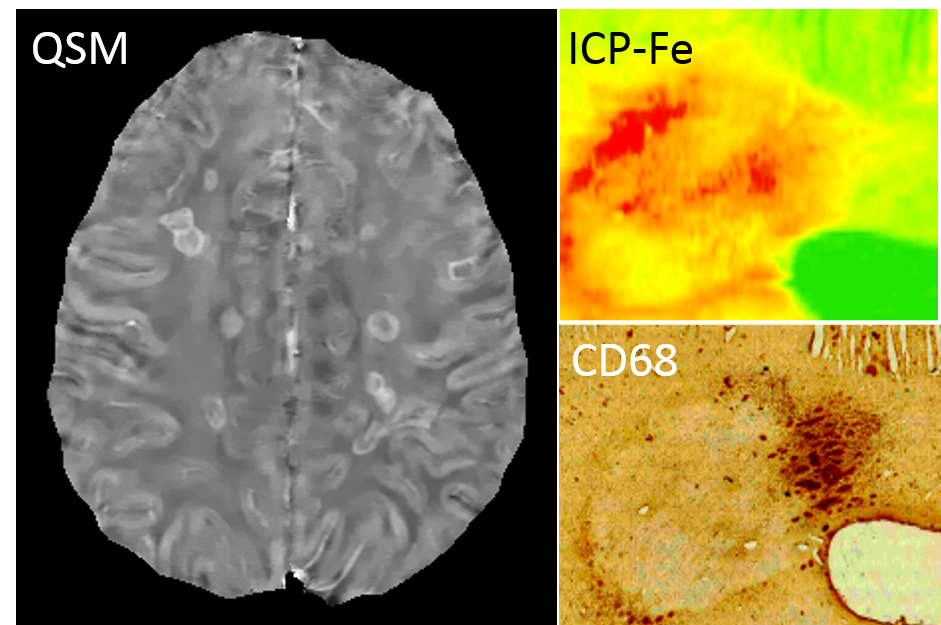

 The long term objective of this project is to improve the capability to monitor the inflammatory and neurodegenerative processes in Multiple Sclerosis (MS) for effective diagnosis and treatment. The specific goal of this research is to establish the time course of magnetic susceptibility of lesions as a sensitive probe of demyelination and iron content associated with inflammatory processes. Currently, gadolinium enhancement in conventional magnetic resonance imaging (MRI) is widely used to map inflammation caused by blood brain barrier (BBB) disruption during MS lesion formation. However, there is still inflammation in the brain after the BBB heals and currently there is no method in clinical practice to detect this inflammation behind the BBB. Our preliminary data demonstrates that the time course of lesion magnetic susceptibility as measured by quantitative susceptibility mapping (QSM) can detect lesion activity after the resolution of gadolinium enhancement. Accordingly, this proposed research will try to establish the existence of and gain a basic understanding of the time course of MS lesion susceptibility by carrying out three specific aims: Aim 1: Improve QSM scanning robustness and processing accuracy for reliable longitudinal measurement of susceptibility time course. We hypothesize that QSM can be improved to high reproducibility and accuracy of 0.01ppm (parts per million, susceptibility unit). Aim 2: Define the MS lesion magnetic susceptibility time course through prospective longitudinal study of the susceptibility of lesions at all ages, with spatiotemporal correlation of gadolinium enhancement measured by conventional MRI. We hypothesize that lesion susceptibility changes dynamically over time, even after inflammatory activity, as measured by conventional MRI, has subsided. Aim 3: Define the immunohistochemical correlates of MS lesion magnetic susceptibility using autopsied brain specimens from MS patients and controls. We hypothesize that the QSM signal of an MS lesion correlates in part with microglia/macrophages activation (i.e. inflammatory activity) and that the QSM value of a fully demyelinated lesion is determined by iron.
The long term objective of this project is to improve the capability to monitor the inflammatory and neurodegenerative processes in Multiple Sclerosis (MS) for effective diagnosis and treatment. The specific goal of this research is to establish the time course of magnetic susceptibility of lesions as a sensitive probe of demyelination and iron content associated with inflammatory processes. Currently, gadolinium enhancement in conventional magnetic resonance imaging (MRI) is widely used to map inflammation caused by blood brain barrier (BBB) disruption during MS lesion formation. However, there is still inflammation in the brain after the BBB heals and currently there is no method in clinical practice to detect this inflammation behind the BBB. Our preliminary data demonstrates that the time course of lesion magnetic susceptibility as measured by quantitative susceptibility mapping (QSM) can detect lesion activity after the resolution of gadolinium enhancement. Accordingly, this proposed research will try to establish the existence of and gain a basic understanding of the time course of MS lesion susceptibility by carrying out three specific aims: Aim 1: Improve QSM scanning robustness and processing accuracy for reliable longitudinal measurement of susceptibility time course. We hypothesize that QSM can be improved to high reproducibility and accuracy of 0.01ppm (parts per million, susceptibility unit). Aim 2: Define the MS lesion magnetic susceptibility time course through prospective longitudinal study of the susceptibility of lesions at all ages, with spatiotemporal correlation of gadolinium enhancement measured by conventional MRI. We hypothesize that lesion susceptibility changes dynamically over time, even after inflammatory activity, as measured by conventional MRI, has subsided. Aim 3: Define the immunohistochemical correlates of MS lesion magnetic susceptibility using autopsied brain specimens from MS patients and controls. We hypothesize that the QSM signal of an MS lesion correlates in part with microglia/macrophages activation (i.e. inflammatory activity) and that the QSM value of a fully demyelinated lesion is determined by iron.